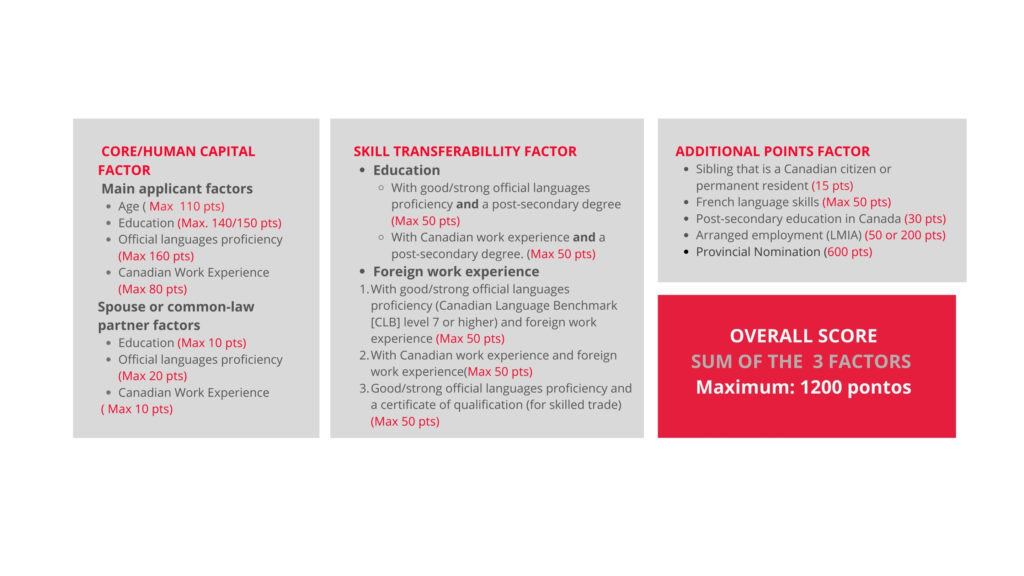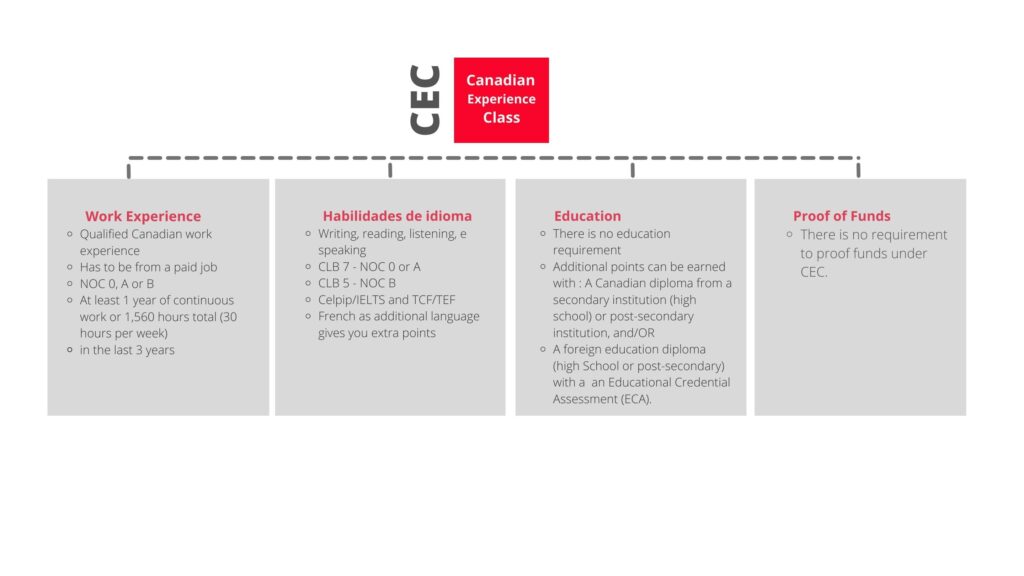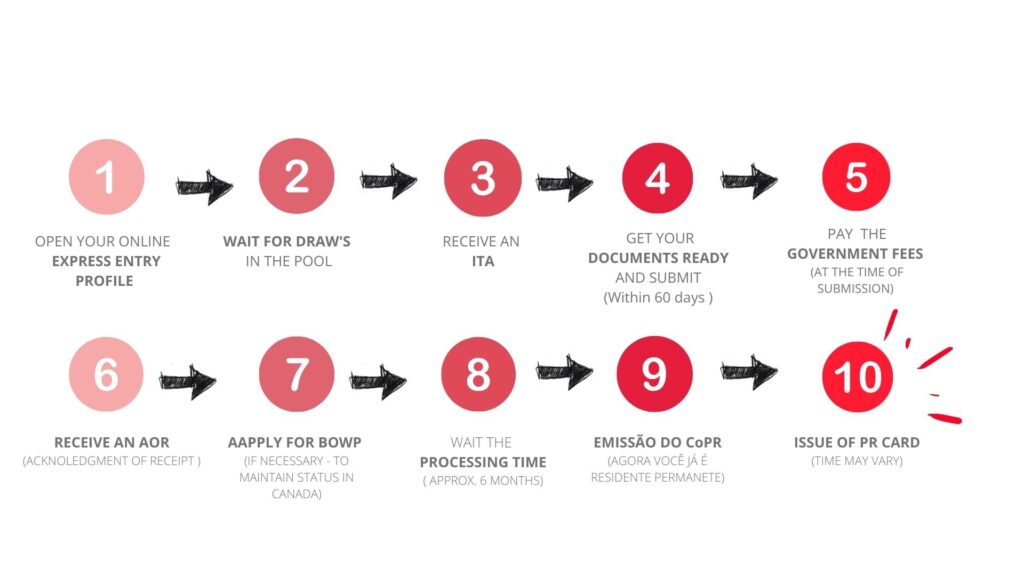The Canadian Experience Class is an Immigration program for foreign workers who have at least 1 year of qualified professional experience in Canada (in NOC’S 0, A or B roles) in the last 3 years before applying, either full-time or the equivalent in hours as part-time , but always with worker status (work experience with student and cooperative status does not count).
ELIGIBILITY CRITERIA
If you meet all of the minimum requirements, immigration will evaluate your application based on:
- your age
- your Canadian work experience
- whether or not you have a valid job offer
- your language skills in french or english
- your adaptability (how well you can settle in Canada)
UNDERSTANDING THE SELECTION FACTOR SCORE
Immigration uses the Express Entry system to assess your eligibility and invite the highest ranked applicants from the pool to apply for permanent residency.
See below how this score is distributed:

CEC MINIMUM REQUIREMENTS

Canadian Experience Class requirements are based on an eligibility approval template. If the minimum requirements are met, the candidate will be eligible to enter the Express Entry pool via CEC.
To apply for the CEC, candidates must meet the following minimum requirements:
Qualified Work Experience
Have obtained at least one year of qualified, professional or technical work experience (NOCs 0, A or B) in Canada, as follows:
At least 1 year of continuous work or 1,560 hours in total (30 hours per week) – you can address this in a few different ways:
- Full-time at 1 job: 30 hours/week for 12 months = 1 year full-time (1,560 hours)
- Equal amount in part-time work: for example 15 hours/week for 24 months = 1 year full time (1,560 hours)
- You can work as many part-time jobs as you need to meet this requirement.
- Full-time work at more than 1 job: 30 hours/week for 12 months at more than 1 job = 1 year full time (1,560 hours)
- Within 36 months (3 years) of the date of application; you can meet this
- Paid work (having received wages or earned commission – voluntary work or unpaid internships do not count);
- Have gained your work experience by working in Canada while under temporary resident status with authorization to work.
Qualified work experience means that you have worked in one of these groups of National Occupational Classification (NOC) positions:
- Management positions (skill type 0)
- Professional jobs (Skill level A)
- Technical jobs and specialized professions (Skill level B)
You must demonstrate that, while working in your primary occupation, you performed the duties defined in the NOC’s main occupational description statement. This includes all essential functions and most of the main functions listed.
Language skills
You will need to take an English and/or French test, in order to find out your level of the language in the following components :
- writing
- reading
- oral comprehension
- oral expression
There are four Canadian government-accepted language proficiency testing organizations:
- For English: CELPIP General or IELTS General
- For French: TEF or TCF
And to be eligible you will need to obtain a minimum Canadian Language Benchmark (CLB) of:
- CLB 7 for positions under NOC 0 or A, or
- CLB 5 for positions under NOC B
Do you speak French and English? Great!
For those who take the proficiency test in both languages, it is possible to earn up to 50 additional points in their express entry profile.
Important Remind: Your language tests are valid for two years from the date of the test result.
They must be valid on the day of the application for permanent residence.
Education
There is no education requirement for the Canadian Experience Class. But if you want to improve your ranking in the Express Entry pool, there are two ways to do this.
If you have studied abroad (out of Canada), you must have:
- A full credential (diploma/Certificate + final transcript)
- An Educational Credential Assessment (ECA) for immigration purposes from a designated institution, showing that your education equals a completed certificate, diploma or degree from a Canadian institution of secondary (high school) or post-secondary institution.
In addition, if you graduated from a Canadian secondary education (high school) or post-secondary institution you may have your express entry profile score favored with an increase of points.
Proof of funds
For application via CEC, no financial proof is required.
Admissibility
You must be admissible to enter Canada .
APPLYING OUTSIDE
The Canadian Experience Class is also open to those who are no longer in Canada, as long as they submit their application within three years of leaving their employment in Canada.
UNDERSTAND THE PROCESS STEP BY STEP

1) DO YOUR LANGUAGE TEST AND OPEN YOUR EXPRESS ENTRY PROFILE
Canadian Experience Class is a program processed through the Express Entry selection system for those willing to immigrate to Canada. Eligible applicants must first express an interest in immigrating to Canada by opening an online Express Entry profile. For that, first you will need to get your Language Exam done, as you will be required to input your exam code and score in order to open your profile.
2) WHILE IN THE POOL, BE AWARE OF THE UPCOMING DRAWS
Those who meet the requirements for this category will be participating in the periodic drawings of the CEC, which selects candidates according to their ranking of points. This ranking always varies according to the number of invitations (people called to apply) vs the total number of people participating in the Pool.
3) RECEIVING AN ITA
Once receiving an invitation (called ITA – Invitation to Apply) the candidate will be able to send their documents to have their application for permanent residence analyzed.
4) SUBMIT THE DOCUMENTS
After receiving the famous ITA (Invitation to Apply) the candidate will have up to 60 days to submit their complete documentation, including the medical exam, language test, Policy Check, sworn translated documents, letters from the employer and due pay stubs.
5) PROCESSING FEE PAYMENTS
Upon submission of documents, the candidate must pay the Government fees. At this first moment there is an option to only pay the processing fee, which currently costs $825 CAD per applicant and $225 CAD per dependent (under 22 years old). Or pay the full amount, processing fee + right of permanent residence fee, which currently costs +$500 CAD per applicant( For dependents under 22 years old there is no such fee.)
Although, It is recommended to pay the full amount of fees ($1,325 CAD p/p) so that there are no delays in the application due to payment processing time.
6) PROCESSING TIME
After submitting the documents, the Immigration promises to process your application within 6 months (but they claim that the deadline may vary).
7)RECEIVE YOUR AOR
Upon submission of documents and payment of the processing fee, the applicant must receive a letter from immigration confirming receipt of the application, called ACKNOWLEDGMENT OF RECEIPT, in the registered email.
8) UNDERSTAND YOUR STATUS DURING THE PROCESS
Applying for permanent residence programs PR does not entitle the applicant under maintained status (formerly called implied status). If the candidate has temporary worker status close to expiration, he must apply for the BOWP (Bridging Open Work Permit) to maintain his status in Canada while wait for his PR application to be processed. To apply for the BOWP, the candidate must attach their AOR letter (mentioned in the previous step) to his application.
10) GRATING YOUR STATUS WITH THE CoPR
Upon having the application approved, the applicant will receive an electronic letter called Confirmation of Permanent Residence (CoPR). This letter already grants the applicant’s status as a permanent resident of Canada.
11) PR CARD
The last processing step is when you receive the PR CARD, the permanent resident card. Sometimes this card takes a long time to be sent out. But don’t worry, as soon as the applicant receives the CoPR, he already has resident status. The PR CARD works just like a travel document, to allow you to enter Canada as a form of proof of resident status .
A popular path for international students
For many international graduates, Canadian Experience Class can offer the fastest and simplest path for permanent residency.
After completing a post-secondary program at a Canadian educational institution, many international graduates may remain in the country with a postgraduate work permit (PGWP). If, during this period, the graduate obtains at least one year of work in a job position under NOC’S 0,A or B, they may become eligible to join the Express Entry pool through Canadian Experience Class (CEC).
Additional Immigration options for Foreign Workers
If you are considering enrolling in the Canadian Experience Class, be aware that there are also additional Canadian immigration options through the various Provincial Nominee Programs that may fit your profile.
STILL GOT QUESTIONS?
- Book an appointment with us to assess your chances of immigrating through the Federal Skilled Worker.
- Follow our youtube channel and our social networks, where we post daily content about immigration, with tips, clarifications and news from the government of Canada.
- See also the comparison between the 3 Express Entry programs here
- Click here to read the full article about the Federal Skilled Worker program
- Click here to read the full article about the Federal Skilled Trade program
Main source of the content : IRCC – www.canada.ca




